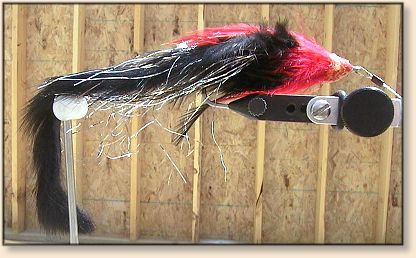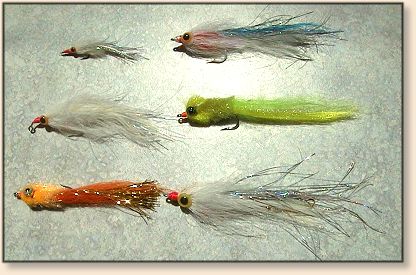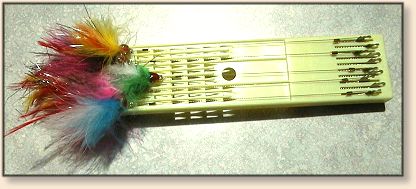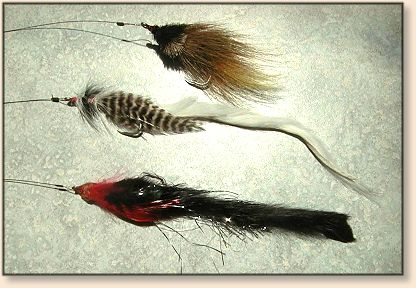Northern Pike and Muskellunge

Most fly anglers who go after northern and muskies
on purpose are usually in a whole different class
than the rest of those in Pan Fishing. Most do it
for the sport, catching and releasing nearly all
of their catches. Most use heavy rods and lines,
usually in the 9 or 10 wt. category and, if they
use tippets at all, they're usually of the steel
variety. If you've ever been fresh water fishing
for bass or crappie, had one mean hit and felt your
line go limp, reeled it in only to find the line
sheared off by something that resembles a knife you
can probably assume it was done by a northern or
musky. These fish are notorious for their sharp
teeth and gill plates and can cut through monofilament
line like a warm knife through butter! On the other
hand, if you're geared up for them and trying to
catch them and have the skill and luck to lay into
one be prepared for something like hooking onto a
freight train once you set the hook. I'm talking
about screaming reels and Nantucket Sleigh Rides!

I've personally watched large northern come up behind
a hen duck swimming with her young hatchlings and pick
them off, one by one, from the row behind her. You
also hear a lot of stories about Muskies being "the
fish of a thousand casts." So what do you use for
equipment and flies and where do you find these
"freshwater barracuda?"

For rods, the smallest I'd recommend is an 8 wt., medium
fast to fast, at least 9 feet long with a fighting butt
for leverage. You can also go with the traditional Spey,
or two handed rod, in the 12 to 14 foot range. The rod
should be equipped with a large arbor reel, about 150
to 175 feet of heavy backing material, a good quality
fly line, followed by an 8 to 12 foot leader made of
something in the 30 to 40 pound test category. I prefer
the Kevlar or braided lines over monofilament because
they have a smaller diameter per line test and are harder
for a northern or musky to cut though.

One tip I'll pass on, and some will argue about it, is
I make a loop connector at the end of the leader. I do
this because I pre-rig all of my northern and musky flies
with a 12 inch steel leader that is crimped onto the hook
and has a loop crimped on the other end. I then keep the
flies on a stretcher board to keep the lines straight and
untangled. When I want to change flies I pick one off the
stretcher, make a loop to loop connection and I'm back
fishing within seconds. Plus, the stretcher board is
great for drying the wet flies that I'm done with.

What type of flies, what sizes and colors do I recommend?
In a word, BIG! Neither of these fish seems to waste time
or energy on snack food. I'm sure that most of you have
heard stories (or experienced it first hand) about someone
pulling in a fish and having the whole thing swallowed by
a northern or musky while they were reeling it in. My
smallest fly hook for a northern or musky is size 0/1,
nickel or chrome plated. I go up as far as size 0/4. Most
of the flies are 5 to 9 inches in length and some have a
smaller, "stinger" hook in them (I prefer catching to
fishing). Most of the flies I build are larger variations
of streamers, others smack of salt water. I've caught both
species on "traditional" looking flies which mimic local
bait fish and I've caught them on orange/chartreuse/blue
color combination Clouser's. The only thing in common is
that they all have heavily epoxied heads. If you want to
use a fly more than once on northern or musky then you
have to apply epoxy at least down past the threads. Even
then, many times the fly will be torn up so badly that
it's not repairable.
How and where do you find and fish for northern and musky?
They range over most of North America and nearly coast to
coast. They live in everything from small streams to large
lakes and both stained and clear water. During the heat of
the day they generally can be found along shady outcroppings
or weed beds. Pure muskies have a smaller range usually
from about the Mason Dixon line to the southern 200 miles
of Canada. Some newer hybrids, like the Tiger Musky, can
live in warmer water and smaller lakes and ponds but don't
get nearly as large as the traditional muskies. I've caught
most of mine early in the morning or in the evening, when
they come out of deeper, nearby water to feed in the
shallows. That's not to say that neither of these species
can be caught during the day, they feed when they're hungry
and they feed on what's available! I've also caught these
predators at high noon, along a shoreline, when it was 90
degrees in the middle of August so don't feel you have to
wait for the perfect time of day or weather. The things
that seem to be common in nearly all the northern and muskies
I've caught is that they were in water less than 8 feet deep
and most hit either a surface or floating fly or one that was
less than a foot under water.

The last bit of advice I'll give you is not to put your
hand anywhere near the mouth of these critters. Use a
long hemostat or long-nosed pliers to remove the hooks
and a sturdy landing net to control them. They've been
known to reduce fingers and hands to something that
resembles hamburger in a matter of seconds. Now go
have fun and be sure to play nice!
fritzfratz@earthlink.net.
~ Fritz Fratz
|





